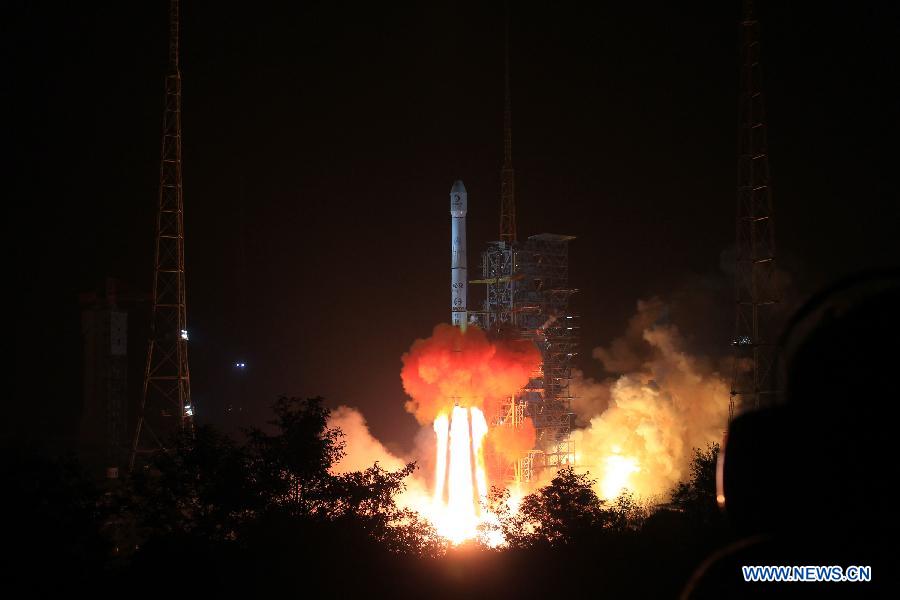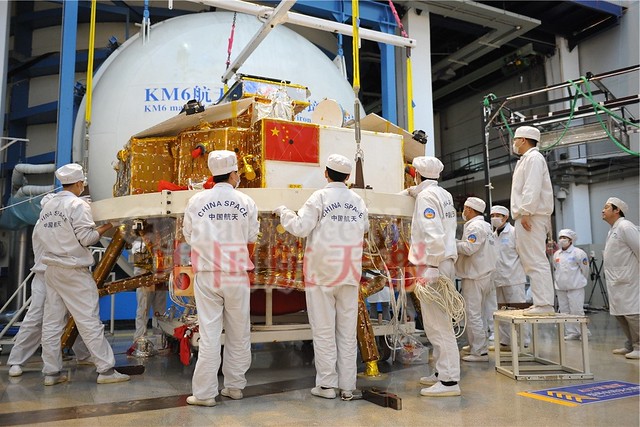 |
| From Sichuan provence, Xichang Satellite Launch Center, Chang'e-3 was launched directly into a transfer orbit 380,000 x 200 km by a modified Long March 3B booster at 1730 UT, December 1 [Xinhua]. |
The Chang’e-3 mission is progressing as planned. China’s third unmanned lunar mission was boosted directly from Xichang into an eccentric transfer orbit with an apogee of 380,000 km, equivalent to the distance to the Moon.
Chang'e-3 mission planner Wu Weiren called the launch, “only a first step in a difficult mission."
If successful, China will become only the third nation to directly explore the "ground truth" of the lunar surface.
Chang’e-3 is expected to be captured by lunar gravity when the spacecraft and Moon both overtake the same area in space relative to Earth, about 120 hours after its launch at 1730 UT, December 1. The spacecraft will be slowed into lunar orbit over the Moon's farside and gradually maneuvered in phases to a low perilune east of a planned landing zone in Sinus Iridum, “the Bay of Rainbows.”
The landing is anticipated sometime after local sunrise at the landing site, in mid-December.
Chang'e-3 mission planner Wu Weiren called the launch, “only a first step in a difficult mission."
If successful, China will become only the third nation to directly explore the "ground truth" of the lunar surface.
Chang’e-3 is expected to be captured by lunar gravity when the spacecraft and Moon both overtake the same area in space relative to Earth, about 120 hours after its launch at 1730 UT, December 1. The spacecraft will be slowed into lunar orbit over the Moon's farside and gradually maneuvered in phases to a low perilune east of a planned landing zone in Sinus Iridum, “the Bay of Rainbows.”
The landing is anticipated sometime after local sunrise at the landing site, in mid-December.
The primary mission of the Yutu (“Jade Princess”) solar powered lunar rover is, reportedly, identifying resources and direct in situ exploration of lunar surface's composition and stratigraphy.
Sun Zezhou, a mission design engineer for the China National Space Administration (CNSA) Lunar Exploration Program (CLEP) said the Chang'e-3 mission "is of great economic as well as scientific importance."
Chang'e-3 is also equipped with an ultra-violet telescope supplied in cooperation with the International Lunar Observatory Association (ILOA) of Hawaii.
The first CLEP lunar orbital missions, Chang’e-1 (2007) and Chang’e-2 (2010) were Stage One of China’s methodical deep space exploration effort. The launch of Chang'e-3 is the beginning of State Two.
A follow-up and roughly identical spacecraft and rover, also a back-up to Chang'e-3, Chang’e-4 is expected to be launched in 2015. Chang’e-5 (2017) and Chang’e-5 (2019) are being developed to return lunar samples.
Sun Huixian, deputy general manager of the CLEP Stage Two, said China’s goals are to retain lunar exploration capacity but, “do not stop at the Moon."
 |
| CNSA workers prepare Chang'e-3, together with its flight-mounted Yutu lunar rover, for static thermal and vacuum testing, last spring [China Space News]. |
Chang'e-3 is also equipped with an ultra-violet telescope supplied in cooperation with the International Lunar Observatory Association (ILOA) of Hawaii.
The first CLEP lunar orbital missions, Chang’e-1 (2007) and Chang’e-2 (2010) were Stage One of China’s methodical deep space exploration effort. The launch of Chang'e-3 is the beginning of State Two.
A follow-up and roughly identical spacecraft and rover, also a back-up to Chang'e-3, Chang’e-4 is expected to be launched in 2015. Chang’e-5 (2017) and Chang’e-5 (2019) are being developed to return lunar samples.
Sun Huixian, deputy general manager of the CLEP Stage Two, said China’s goals are to retain lunar exploration capacity but, “do not stop at the Moon."
"China aims for deeps space,.” Sun said.
 |
| Rare on Earth, estimated locations (as percentage by weight) of Helium-3, implanted the lunar surface by solar wind, estimated using the titanium-O2 as proxy . |
Some of China's scientists, meanwhile, wrote of hopes for future international cooperation in the space sciences and in the exploration of the Moon and beyond, especially with neighboring India.
This last may have been in recognition of the successful, final boost out of Earth orbit of ISRO's Mangalyaan, its Mars Orbiting Mission (MOM), dispatched to explore the atmosphere of Mars beginning in September 2014.
Deputy CLEP chief Li Benzheng said China hoped not merely "to stir up competition in space exploration."
Deputy CLEP chief Li Benzheng said China hoped not merely "to stir up competition in space exploration."
"We are taking the path of openness, with respect to our lunar exploration plans," Li wrote. "We hope to promote space exploration, that it can be done for the use of space resources for the development of mankind."
• Xinhua article (English)
• Xinhua article (English)
• Chang'e 3: Xinhua Special Issue (English)
• Chang'e Plan (lunar exploration information, moonstation.jp)
Junya Terazono (moonstation.jp) and Phil Stooke greatly contributed to this report.

No comments:
Post a Comment